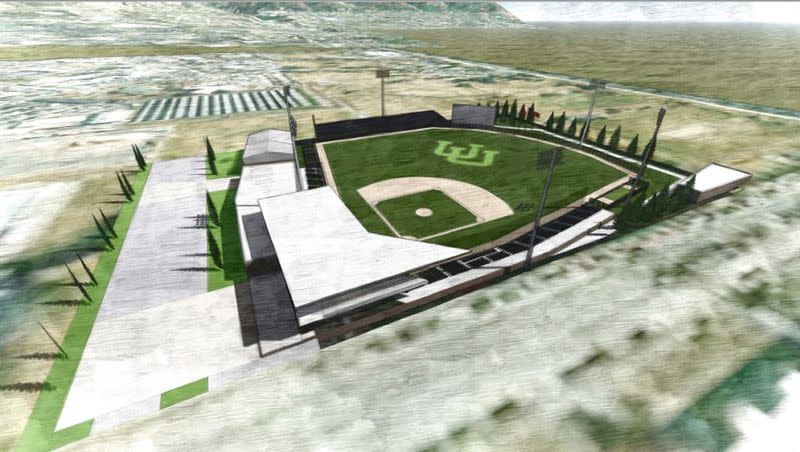Finally: Utah Athletics gets ‘contingency approval’ to build $35 million on-campus baseball stadium

Seven years after then-Utah athletic director Chris Hill revealed that plans were underway to build an on-campus baseball stadium so the Utes wouldn’t have to play at the Salt Lake City-owned minor league ballpark downtown, the project has received a partial green light from the university’s board of trustees.
“This is also a tremendous opportunity for us (in) finalizing our quest to find an on-campus home for Utah baseball that has been pursued for nearly 10 years.” — Utah athletic director Mark Harlan
The stadium proposed to be built on Guardsman Way at the site of the current baseball practice field — across the street from the football facility — will seat fewer people and cost nearly five times more than what Hill told the Deseret News it would in 2016.
Current athletic director Mark Harlan, who has been the driving force behind the latest movement to get the project back on the drawing board, said in a school news release that a fundraising drive has already been launched and the bulk of the project will be privately funded.
Utah hopes to be playing in the new stadium in the 2025 season.
Plans call for the stadium to have a capacity of 1,200 fans and the total project is expected to cost $35 million. In 2016, it was going to seat 2,000 fans at a cost of $7.5 million, per Hill’s comments at the time.
The board of trustees granted “contingency approval for the project” at its regularly scheduled meeting Tuesday morning, the athletic department’s news release said. It did not elaborate on what those contingencies entailed.
The new stadium space will include concessions, restrooms, ticketing offices, team facilities (including locker rooms) and coaches offices.
“I’d like to thank the trustees for their approval to move forward with this important project to support our baseball program with a stadium on our campus,” Harlan said. “We have incredible engagement from donors, and we are actively working to reach our fundraising goals.”
Utah currently plays its home games at 15,411-seat Smith’s Ballpark, home of the Triple-A Salt Lake Bees, a minor-league affiliate of the Los Angeles Angels.
Bees ownership announced in January that the it plans to move the team to South Jordan and build a new stadium in the Daybreak development. The stadium in SLC will likely be demolished following the Bees’ final season there in 2024.
Twice this current season Utah has played at BYU’s Miller Park in Provo because Smith’s Ballpark was not available, for various reasons.
“We’re very appreciative of the terrific partnership we have enjoyed for nearly three decades with the Salt Lake Bees and the city for our baseball program to play its home games at Smith’s Ballpark,” said Harlan. “This is also a tremendous opportunity for us (in) finalizing our quest to find an on-campus home for Utah baseball that has been pursued for nearly 10 years.”
Related
Utes hoping to build $7.5 million on-campus baseball stadium
The Salt Lake Bees are getting a new stadium in South Jordan. When will it be completed?
As many as eight potential sites surfaced in 2016, and that list was trimmed to five by a study in 2019 — including two sites on Guardsman Way.
“The goal and purpose for this location on Guardsman Way is that it provides the most beneficial site for our baseball program and our fans,” Harlan said. “For our student-athletes it is situated in close proximity to other athletics facilities, including our dining facility in the Spence and Cleone Eccles Football Center, and for our fans it provides ample parking and ease of access on game days.”
Chief facilities officer Robin Burr said the university is sensitive to concerns raised by neighbors about traffic, parking, noise, field lighting and safety. Utah plays between 22-24 home games during a typical season, which runs from March through May.
About half of those games are played at night.
“Noise, light, safety and traffic have been the consistent concerns raised, and our design addresses each of these factors,” Burr said. “This new design is also scaled back from proposals and fits nicely on the space we have designated.”
Harland said Utah’s “ultimate vision” for the facility is that it becomes a “community asset” that benefits all levels of baseball in the city and state.
The playing surface will be field synthetic turf, which should allow the U. to rent out the facility to other institutions and entities, while also allowing high school games, tailgating during football games, and other opportunities for income.
If the current proposal stands, the field will be 330 feet to the foul poles in right and left field, while the center field fence will be 400 feet straightaway. The left field wall will be a “mini-green monster” a smaller version of what exists at Boston’s Fenway Park.
The left-field wall would be 30 feet high; Fenway’s left-field wall is just over 37 feet high.
Due to field conditions at Smith's Ballpark, the Utah baseball game vs. Arizona State on Friday, March 17 has been moved to Miller Park in Provo.
First pitch will now be at 5 p.m. MT.
More details ⤵
📰 https://t.co/v6V7scfsqB#GoUtes pic.twitter.com/KFQ3TDZksq— Utah Baseball (@utahbaseball) March 16, 2023

